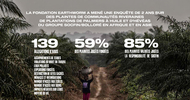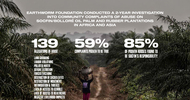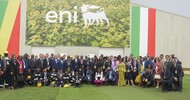Asia Sentinel | 03 May 2009
Written by John Berthelsen
Last July, accompanied by a gaggle on smiling Indonesian officials including Anton Apriyanto, the Indonesian agriculture minister, the Saudi Binladin Group, a Saudi Arabian construction conglomerate owned by the family of international fugitive Osama bin Laden, announced it planned to spend US$4.3 billion on a massive half-million hectare area most recently covered by primary forest in Merauke, Papua, to grow rice and other crops.
A year later, the Binladin plan has been quietly scrapped, as apparently has another plan by Chinese interests to tear out a million hectares of primary forest in Kalimantan and replace it with oil palm. The Kalimantan plan is regarded as mostly yet another effort by Indonesia's timber barons to denude vast tracts of Borneo for its vast timber assets.
Nonetheless, the two proposals illustrate both the problems and possibilities of a new subject that is disturbing environmentalists and NGOs: food security. Agriculture is in for a revolution, not only via trade but in vertical integration and technology. Rich countries that don't have enough land to grow their own food have been characterized as land grabbers buying up vast tracts of poor countries, particularly in Africa, to cultivate the land they need to feed their people. And many of those countries don't like it, or, as in Indonesia's case, don't have the infrastructure in place to give them what they want.
On Wednesday, May 6, Angel Gurria, the secretary general of the Organization for Economic Cooperation and Development, and Jacques Diouf, the director general of the United Nations Food and Agriculture Organization, are expected to chair a joint meeting in Paris, to "bring together international experts to discuss a range of agricultural, development and trade policy issues" seeking to deal with the entire panoply of problems being kicked up by the issue of food security. Diouf has been particularly concerned, saying that "The race by food-importing countries to secure farmland overseas to improve their food security risks creating a 'neo-colonial' system."
Although the issue of importing food from other countries goes back thousands of years, when the granaries of Rome were supplied from Northern Africa, it has taken new impetus from the so-called food shock kicked up by the skyrocketing prices of commodities in 2008, in which rice, for instance, rose from US$250 a ton to nearly US$1,000. Soyabeans, maize and wheat all rose dramatically as well. Food riots hit at least 30 countries and brought down the government in Haiti. And, while prices have descended considerably from those highs, rice remains 49 percent above its 10-year average, maize is 43 percent above, soyabeans are 36 percent above, and wheat remains 31 percent above.
That has sent land-poor but cash-rich countries searching across the globe to seek out cash-poor and land-rich ones, creating new industrial models and changing the very face of agriculture, raising alarms, as the International Food Policy Research Center in Washington, DC put it, over "the impacts on poor local people, who risk losing access to and control over land on which they depend."
In a matrix put together last week by the IFPRA, Bahrain is said to have taken on a 10,000 hectare tract in the Philippines, China 101,171 hectares in Zimbabwe, Libya 250,000 ha in Ukraine, Qatar 40,000 ha in Kenya, the UAE 324,000 ha in Pakistan, South Korea 690,000 ha in Sudan and Jordan 25,000 ha in Sudan. Those are only scattered samples.
Nor are they alone by any means. In April, South Korea's Hyundai Heavy Industry, the country's largest shipbuilder, announced it would pay US$6.5 million for 67.6 percent of Khorol Zerno, the owner and operator of 10,000 hectares of land in the Russian Far East and would invest another US$9 million to purchase another 40,000 hectares to expand the farmland to 50,000 hectares by 2012.
At almost exactly the same time, Saudi Arabia announced it would put US$800 million into a new public company to invest in overseas agriculture projects in an effort by the Riyadh government to outsource the supply of food to the fast-growing kingdom, which spent at least US$86 billion starting in the 1960s on a disastrous project to raise its own wheat. That project now has been abandoned completely after the country drew down its underground aquifers to the point where few oases now exist within its borders.
Pakistan, no reluctant bride, has sent its investment minister, Waqar Ahmed Khan, across the Gulf offering to sell or lease 404,000 hectares of farmland to any foreign country looking to secure its food supplies, according to agra-net.com, a European website serving the global agrifood industry.
Thus the outsourcing of food has suddenly become a very big business. Richard Ferguson, a Europe-based analyst for the Japanese investment bank Nomura, calls what is going on now the "third great wave" of outsourcing after manufacturing in the 1970s and 1980s and information technology in the 1990s and 2000s. Ferguson, in his exhaustive 319-page report, talks about the future of farming in terms of 1 million-hectare operations.
How much it has to do with sovereign governments buying up land in other countries is questionable, however. Government officials have begun to realize that ownership of blocks of agriculture land in the Argentine pampas would no more insulate their produce in time of crisis than their bankers' funds were insulated from default in the 1990s when Argentina decided to pull the plug on tens of billion dollars in unserviceable debt. There is also the problem, across Africa in particular, where ownership of land is a cultural imperative and selling it to the Chinese or the Saudis is liable to start riots. The Chinese in particular publicly announced in April that they would not pursue an agricultural acquisition program in Africa, although private Chinese companies have expanded quietly and considerably in Burma and Laos and are active in other Asian regions.
But what undeniably is taking place, according to Ferguson's exhaustive 319-page report, titled "A Revolution of Sorts," is that huge change is coming to the production of food. It is being outsourced across borders as never before and dramatically changing the nature and shape of agriculture itself. Not only are foodstuffs being hauled thousands of miles across oceans and the skies, but the industry is being integrated vertically, with new multinational corporate entities coming into play and with trade patterns expected to change as well.
"In our view," Ferguson wrote, "some of the structural changes taking place across the agricultural sector mirror the Internet frenzy of the late 1990s. Both center on industries which have been around for generations but which are being transformed into something quite different to what preceded them."
Both, Ferguson wrote, have attracted a rush of venture capital into mostly unproven startup enterprises, going up against incumbents like Cargill, Archer Daniels Midland and others which have dominated the agriculture trading market the same way incumbents dominated the telecoms market, and new technologies and processes are generating new market participants and drawing talent away from the universities to participate in them.
The implications for trade, Ferguson writes, are manifold.
The Doha round of agricultural trade negotiations, dead on arrival for nearly a decade, is starting to look viable. It is no accident that Brazil, which is one of the world's major exporting countries, is leading global attempts to push through trade reform while countries seeking to protect their own farmers like South Korea and India are bucking the trend. But, Ferguson writes, it is a trend that probably will be unstoppable.
- Huge investor-owned farming companies are coming into being, like the British-controlled but Ukrainian-based Black Earth Farming, Kernel Group and other CIS-bloc farming companies that have come into being and gone public in the half-decade.
- Farms are about to get a lot bigger, more able to invest in logistics, communications and information systems, with increasing economies of scale that will drive down costs.
- A two-tier system is developing in which agriculture will be dominated by smallholders over the next decade or so, but that many large-scale farming units will emerge, some with formidable operational and financial firepower,
This is hardly music to the ears of the world's environmentalists and anti-capitalists, already alarmed by the vast industrialization of agriculture that has produced assembly-line veal, beef and poultry and, they say, raised alarming levels of antibiotics in meat, drawn down water tables across many countries, pushed smallholders off the land and resulted in a myriad of other increasingly frightening health and environmental problems. The agriculture these new entities will be practiced will almost certainly be based on American farming techniques, including land levelers as big as football pitches, huge GPS-positioned tractors and harvesting machines, etc. In the US in the latter half of the 20th century:
- The average amount of milk produced per cow increased from 2,410kgs to 8,250kgs per year.
- The average yield of corn rose from 39 bushels to 153 bushels per acre
- Each farmer in 2000 produced on average 12 times as much farm output per hour worked as a farmer did in 1950.
- Between 1948 and 2004, agricultural commodity prices rose at less than half the rate of prices in the wider economy.
- Capital, land, labor, chemical and energy inputs to agriculture fell even as agricultural output continued to grow, with increased productivity driving all of the output growth.
That's the good part. The number of people employed in agriculture fell constantly from 1948 to 2004 by a rate of about 4 percent a year. A huge area of the Gulf of Mexico is now a dead zone because of the phosphates and other fertilizers washed down the Mississippi River from the nation's agricultural heartland. Many critics believe the United States is daring a major epizootic because of the increasing vulnerability of farm animals to disease now being kept under control by antibiotics.
But the fact is that given increasing population pressures, growing world wealth and trade pressures, that is the way this revolution in agriculture is shaping up. Already, according to the IFPRI, Japan's overseas corporate agricultural holdings are three times the country's own arable land. World agricultural exports have soared upwards, with total grains expected to hit a record 676.3 million tons in the 2008-2009 year, according to the World Agricultural Outlook Board, with international agricultural sales probably even more interlocked than, say, electronics.
In the last decade, according to the US Department of Agriculture, global beef exports, crisscrossing the world from the US, Brazil, Argentina and other countries, have grown steadily if not spectacularly from 55,576 million tons to 59,250 million. Pork exports have grown from 92,673 million tons to 96,710 million tons, poultry from 64,583 million tons to 77,038 million. It is unlikely that any of these volumes are ever going to fall unless there is some cataclysm we do not at this point know about.










